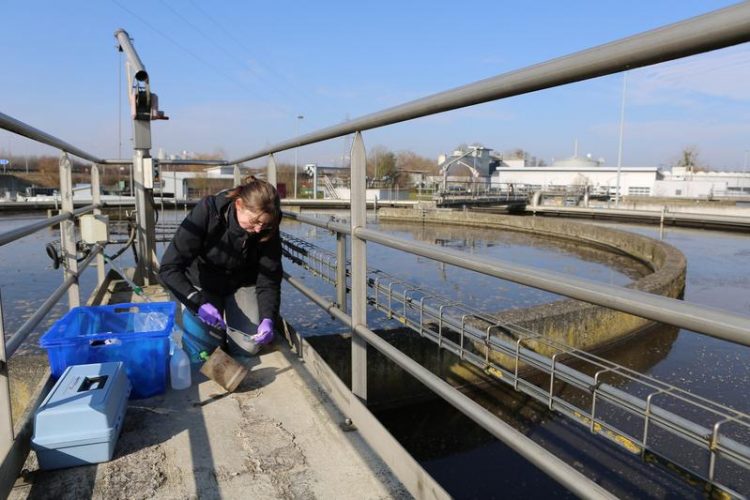Keystone species: Which are the most important functional genes in an ecosystem?

The researchers took samples from a wastewater treatment plant during different seasons. They then characterised the entirety of all genes. LCSB 2015
Keystone species are species that play central roles in the functioning of ecosystems. These are typically not the most abundant species but far more important are organisms carry copies of distinct, essential genes – researchers here speak of “keystone genes” – which are also transcribed disproportionately often.
The insights from the group of FNR-ATTRACT fellow Prof. Paul Wilmes are also of medical importance: When microbial communities come out of balance in the course of disease, a positive health effect may be achieved by supporting keystone bacterial species in a targeted fashion. The study was published in the new journal of the Nature Publishing Group, npj Biofilms and Microbiomes (http://www.nature.com/articles/npjbiofilms20157).
So far, scientists have had difficulties in analysing the dependencies between the many bacteria in a complex ecosystem such as the gut or a biological treatment plant. In most cases, they record the different species that occur together under changing environmental conditions. Similar patterns of variation are hereby considered an indication of interaction and highly connected species are thought to represent keystone species.
“The emergence of the new omics technologies, including genomics, transcriptomics or proteomics, has brought with it entirely new and exciting possibilities for researching ecosystems,” Paul Wilmes says. “After high-throughput analyses, in which we collect giant quantities of data, we can now infer community-wide networks on the computer. From these, we can for example identify key functional traits within the community and we are then able to attribute such traits to specific community members.”
To achieve this, Wilmes and his group took samples from a wastewater treatment plant during different seasons. They then characterised the entirety of all genes, analysed what genes were being transcribed and gained an overview of the resulting proteins.
“With this combination of metagenomics, metatranscriptomics and metaproteomics, we were able to reconstruct the metabolic networks of the community at a given point in time,” says Dr. Anna Heintz-Buschart, LCSB scientist and first author of the publication. “This tells us what substances can be produced by the community in general, what genes exist in multiple copies in different bacterial species and in what quantities certain proteins are produced.”
Armed with this knowledge, the researchers then went about first identifying “keystone genes” and linking these to keystone species. “The identified genes and species fulfil essential functions in the ecosystem,” Paul Wilmes explains: “Many metabolic pathways and species are dependent on them. When they are absent, it has dramatic consequences for the entire ecosystem. But, if you were to learn on how to support them, then the ecosystem would likely be more productive and resilient.”
LCSB director Prof. Rudi Balling explains the medical importance of the new insights: “We assume that diseases such as Parkinson’s could in part be caused by a disruption in the composition of microbial communities in the human body. With this knowledge about keystone genes and species, we can take a closer look at the molecular causes in future – and explore measures for restoring ecological balance in the gut, for example.”
http://www.nature.com/articles/npjbiofilms20157 – Scientific publication
http://wwwen.uni.lu/lcsb/people/paul_wilmes – Personal web page of Associate Professor Paul Wilmes
http://wwwen.uni.lu/lcsb – Homepage of the Luxembourg Centre for Systems Biomedicine (LCSB)
Media Contact
All latest news from the category: Life Sciences and Chemistry
Articles and reports from the Life Sciences and chemistry area deal with applied and basic research into modern biology, chemistry and human medicine.
Valuable information can be found on a range of life sciences fields including bacteriology, biochemistry, bionics, bioinformatics, biophysics, biotechnology, genetics, geobotany, human biology, marine biology, microbiology, molecular biology, cellular biology, zoology, bioinorganic chemistry, microchemistry and environmental chemistry.
Newest articles

Decoding Cancer: 40 Years of Breakthroughs in Genetic Research
Cancer in children and adolescents is rare. Nevertheless, malignant diseases are still one of the most common causes of death in this age group. Survivors of childhood or adolescent cancer…

Let’s Think Before the First Drink: How Early Substance Use Might Lead to Brain Structure Differences Among Adolescents
Many differences appeared to exist prior to any substance use, pointing to the role brain structure may play in substance use risk, NIH-supported study suggests. Studies reveal factors that expose…

Combating Kidney Cancer Using Enhanced Immunotherapies
Medical University of South Carolina Hollings Cancer Center researcher receives Department of Defense Early Career Scholar Award to improve immune therapies by targeting resistant kidney tumors. A Medical University of…



